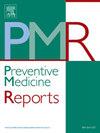The association between learning models and child health behaviours during the COVID-19 pandemic
IF 2.4
3区 医学
Q2 PUBLIC, ENVIRONMENTAL & OCCUPATIONAL HEALTH
引用次数: 0
Abstract
Objective
This paper aimed to explore the association between school learning models (virtual vs. in-person) and child health behaviours (daily screen time, physical activity, outdoor time, sleep duration, and sleep onset time) during COVID-19, and whether these associations were modified by child's age, sex, and family income.
Methods
A longitudinal cohort study was conducted among children four to 13 years from the TARGet Kids! COVID-19 Study of Children and Families between November 2020 and July 2022. TARGet Kids! is a primary care research network in Ontario, Canada. Data on sociodemographic characteristics, child school learning models and health behaviours were collected from repeated parent-reported questionnaires. Linear mixed effects models were fit adjusting for confounders identified a priori.
Results
A total of 367 children [51 % male; 7.3 (± 2.2) years] with 779 observations on school learning model were included. Compared to in-person learning, virtual learning was associated with higher daily screen time (0.22 h; 95 % CI 0.03, 0.40), higher outdoor time (0.71 h; 95 % CI 0.56, 0.86), higher physical activity (0.64 h; 95 % CI 0.44, 0.85), and a later sleep onset time (0.22 h; 95 % CI 0.15, 0.28). Older children had higher daily outdoor time, girls had a later sleep onset time and children with a family income greater than $150,000 reported higher daily physical activity.
Conclusions
Virtual learning was associated with higher daily screen time, outdoor time and physical activity, and later sleep onset time during the pandemic.
COVID-19大流行期间学习模式与儿童健康行为之间的关系
目的探讨COVID-19期间学校学习模式(虚拟与面对面)与儿童健康行为(每日屏幕时间、身体活动、户外时间、睡眠持续时间和睡眠开始时间)之间的关系,以及这些关系是否受到儿童年龄、性别和家庭收入的影响。方法采用纵向队列研究对目标儿童中心4 ~ 13岁的儿童进行研究。2020年11月至2022年7月儿童和家庭COVID-19研究。目标的孩子啊!是加拿大安大略省的一个初级保健研究网络。从家长重复报告的问卷中收集社会人口特征、儿童学校学习模式和健康行为的数据。线性混合效应模型拟合调整了先验识别的混杂因素。结果患儿367例,男占51%;7.3(±2.2)年],共纳入779例学校学习模型观察。与面对面学习相比,虚拟学习与更高的每日屏幕时间相关(0.22小时;95% CI 0.03, 0.40),户外时间较长(0.71 h;95% CI 0.56, 0.86),较高的体力活动(0.64 h;95% CI 0.44, 0.85)和较晚的睡眠开始时间(0.22 h;95% ci 0.15, 0.28)。年龄较大的儿童每天的户外活动时间更长,女孩的睡眠时间更晚,家庭收入超过15万美元的儿童每天的体育锻炼时间更长。结论虚拟学习与流感大流行期间每天屏幕时间、户外活动时间和身体活动时间增加以及睡眠时间推迟有关。
本文章由计算机程序翻译,如有差异,请以英文原文为准。
求助全文
约1分钟内获得全文
求助全文
来源期刊

Preventive Medicine Reports
Medicine-Public Health, Environmental and Occupational Health
CiteScore
3.90
自引率
0.00%
发文量
353
 求助内容:
求助内容: 应助结果提醒方式:
应助结果提醒方式:


